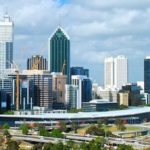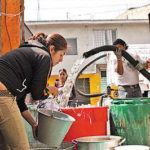 Three great days in Melbourne in which I met with many asset managers for talks over coffee (or the hard stuff).
Three great days in Melbourne in which I met with many asset managers for talks over coffee (or the hard stuff).
The benefits of a podcast series addressing future change and its impact on infrastructure decisions today was readily recognised and the ability of the podcast to draw from the perspectives not only of those who are responsible for the supply of public infrastructure, (decision makers, analysts, managers and advisors) but also those who rely on infrastructure to achieve community and commercial outcomes was seen as something that people wanted to be involved in. Think those who supply and those who rely!
I was able to meet with Anne Gibbs, the current CEO of the Asset Management Council, who has been extremely helpful in providing follow up material, and with Sally Nugent, the former CEO, as well as a number of active AMC members including Andrew Sarah, Greg Williams and Kieran Skelton. I also had a very positive meeting with Jaimie Hicks, Business Development Manager of the Water Services Association, Australia.
Lara Morton-Cox of the Victorian Treasury drew my attention to innovative work they are doing to encourage future thinking to be built into agency asset management plans. It was also a pleasure to catch up with new friends and people I had not seen for some time – Roger Byrne, Claudia Ahern of Creative Victoria, Christopher Dupe now Manager, Capital Works Programs at Museums Victoria, Brenton Marshall, Shellie Watkins, Thomas Kuen of Melbourne Water, Steve Verity of TechOne, Roger Harrop, Ian Godfrey, Gary Rykers, Dr Nazrul Islam, David Francis, and Greg Williams,
On Friday morning I was able to catch up with Robert Hood, who is now working with Asia Development Bank developing asset management expertise and believes that our infrastructure decision making podcast may have relevance to their work. I also met Robert’s wife, Cherry, from Capital Works Planning at the University of Melbourne who had some interesting ideas and we will talk in October about student involvement in our podcasts.
In the afternoon, a magic time with Ashay Prabhu and his fantastic team of energetic, imaginative and committed young people at Assetic. And finally, a leisurely and interesting conversation over wine with Tom Carpenter, trainer and CEO of the Institute of Quality Asset Management.
I will be back in Melbourne mid October, so if you missed out this time, let’s catch up in October.
Penny will be in Melbourne this week meeting with those interested in participating in the podcasts, as researchers, publicists, administrators and/ or as on air talent. Later she will be in Brisbane, Canberra and Sydney and more information about those visits will be posted.
NOTE: Blog posts will now be on an occasional basis rather than regular twice weekly posts.
Write to penny@talkinginfrastructure.com if you would like to be invited to forthcoming podcast discussions.

How might drones affect your life cycle?
Understanding the life cycle – from asset creation to maintenance, to disposal and/or rehabilitation and reconstruction, is a fundamental concept that many need to know. But different groups need to know it in different ways. We fail to communicate if the language we speak is not the language the listener understands. So consider some of the different needs.
- Elected members and all political decision makers need to understand the impacts of life cycles in terms that they can relate to – current and future service delivery and risk. They need to know this in broad terms, but they do not need the technical details.
- Policy, planning and finance people need to understand how to measure costs and timing so that they can plan to match future revenues and expenditures, They need to understand that predictions from our models are based on ‘average’ economic life cycles. Here we face a dilemma. More closely specifying our asset groups enables more accurate descriptions which helps to determine more accurate economic life averages. But it also reduces the size of each asset group and the reliabiity of averages diminishes as the numbers in the group diminish.
- Technical people need to understand it in terms of long term optimisation rather than short term. Their knowledge need is not so much dollars as technical intervention events, e.g. maintenance or renewal.
Understanding the life cycle in all these ways is essential to ‘keeping the show on the road’, and all of the above groups have taken this as their objective.
But the ‘day after tomorrow’ requires more.
Those of us advising Infrastructure Decision Makers need to do more, we have to be able to anticipate the nature and impact of changes in the life cycle itself. Along with elected members, policy, planning, finance and technical folks, we are concerned to enable functionality today and tomorrow but, in addition, we also need to ensure that we are able to take advantage of technological options and anticipate demand changes so that we may understand the changes in the life cycle itself, arriving the day after tomorrow*.
*And for more on future change and its impact on us see the coming IPWEA event in Sunday’s weekly round up!

Our podcast partner, the IPWEA, will hold its Asset Management Congress “Communities for the Future, Infrastructure for the next generation” in Canberra, 14-16 August. And Talking Infrastructure will be there – presenting and recording.
Talking Infrastructure will be selecting key topics, ideas and speakers at this congress to appear in our Talking Infrastructure Podcast. The intention, however, is not to simply reproduce the congress in podcast form, as interesting as that might be, but rather to use the ideas presented as the core, and to augment the ideas presented by asset managers, with viewpoints from other specialists and other disciplines, in order to build up a more complex picture. We will be drawing not only from the work of the invited speakers, but also from the commentary by the audience. So be there! Be in it!
This congress has been designed to be highly interactive – see the full program details here

I hope that you have enjoyed thinking about Doug Bartlett’s Four Post series on ‘words matter’. So why not grab yourself a cup of coffee and sit down and write a comment? If you agree with the interpretation that Doug has adopted, do tell him, and tell us why. Equally, if you would have interpreted the words (and the challenge that goes with them) differently, tell us that, and why. If you have useful examples, add them.
There is plenty of scope here for comment and now there are TWO reasons for doing so.
- As a thank-you to the blog poster, a courteous acknowledgement.
- As potential for ideas, topics and speakers for our coming Podcast series
If you have not yet caught up with our news on our coming podcast, see our Weekly Roundup, Sunday July 1st. – and watch for updates in our coming Sunday round-ups.
Note:
Latest comments show up in the right hand side bar here on the front page, as well as being attached to the post itself. So add comment to any post. It doesn’t have to be the most recent to be seen.
This is the last in our ‘words matter’ series by Douglas Bartlett, Manager Asset Planning, City of Kalamunda, and member of the Perth City Chapter. Is this how you would interpret growth and prosperity for all? Doug welcomes your responses and alternatives.
 Growth is a concept based on natural systems and leads to efficient forms (such as living creatures). Aside from the biological growth, there is also the ability for an individual to grow in experiences, learning, and skills, which may or may not have limits. Growth in populations can be geometric and uncontrolled, limited by resources with ‘natural’ controls via food, space, reproduction rates, predators.
Growth is a concept based on natural systems and leads to efficient forms (such as living creatures). Aside from the biological growth, there is also the ability for an individual to grow in experiences, learning, and skills, which may or may not have limits. Growth in populations can be geometric and uncontrolled, limited by resources with ‘natural’ controls via food, space, reproduction rates, predators.
Using the context of the growth of the living creature, can we change the language or philosophy behind AM ‘Growth and Demand’ such that our community and its assets is considered to be a living organism which grows to create its most efficient form? This implies that the eventual form is matched to the limit in resources. This language would replace the mathematical population growth models, that are theoretically without limit. In our modelling of course, we must place a conceptual limit to growth because at some level we are unable to imagine the size of the population.

Mexico water shortage. Filling up from water trucks.
Prosperity can include concepts of equity, opportunity for a job, a business, to eat, learn, have shelter, recreate. Prosperity is a present state measure and is measured against historical states or other communities. There is no future focus so if we adopt ‘Prosperity’ as the objective:
- we may struggle or suffer from a lack of perspective of future impacts/threats, and
- we may not be able to react to change.
When considering the change of word from growth to prosperity we must also remember that AM looks at ‘Growth and Demand’ not just growth. ‘Demand’ introduces an economic perspective whereby the price increases until the demand and price are balanced within the marketplace. In terms of AM this means people will demand more (quantity, quality, time, less cost) until a point that the service exceeds their desire to pay for it. But in reality the point we try to each is where people become comfortable (with what they have) and no longer seek or expect more. Also the community is not directly exposed to the cost of things, as they pay taxes and receive services but there is almost no direct connection between them. So: we are trying to determine the demand for services, and demand is met once people become comfortable.
Putting these ideas together: growth in a living organism, ensuring we keep a future focus, and demand reaching a level of comfort: the service provided by assets needs to be modeled so that the service is expected to grow and change form, metamorphosing into a new service that is more efficient for the community: The new butterfly effect.

‘Talking Infrastructure’ is about to produce a podcast series. Its focus is “rethinking infrastructure decision making for the 21st century”.
Partnership
We are delighted to welcome the partnership of the Institute of Public Works Engineering Australasia (IPWEA) in this venture.
Thinking IDM
Public infrastructure investments typically have a long life, affect large populations with diverse needs, extend over large territories, and are not only difficult (and sometimes impossible) to change or undo, but have high capital and ongoing costs, and substantial (and often insufficiently recognised) opportunity costs. For all these reasons, public infrastructure decision making has always been challenging. In other words, we have always had to think!
Rethinking IDM
But there is now an extra dimension. Change is always with us, so why do we consider 21st century change more critical? (Apart from the fact that it is where we are now!)
First there is the magnitude, rapidity and scope of change occurring simultaneously on many fronts – technological, demographic, environmental – as well as in public attitudes towards our key decision makers in government, institutions, science, finance and education.. There is a major political shift occurring across the world increasing the sense of fear and scarcity, just when technological change is increasing the opportunity for us to have hope and abundance. To which must be added the need to address cyber terrorism and the communication difficulties introduced by a post-truth world.
If ever rethinking was necessary, it is now.
Our intended audience is all who want, or need to, understand and shape the future of public infrastructure.
This includes academics, bureaucrats, politicians, and political advisors, as well as investors, financiers, and, of course, asset managers.
Keep watching, more information to come!

Recent Comments